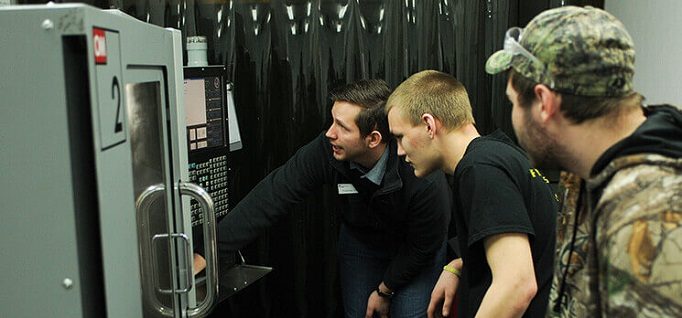Building a SMART future
By Madeline Patton
October 18, 2018
An Advanced Technological Education project opens opportunities for rural high school students.
Andrew Kott is the “perfect technician” to teach rural high school students about automated warehouses and supply chain technologies, according to Shamus Funk.
As principal investigator of the Smart Manufacturing and Resources for Transforming the Future (SMART Future) project, Funk hired Kott to teach students and to work with high school teachers in Chippewa Valley Technical College’s (CVTC) Mobile Manufacturing Lab.
“Students respond well to him,” Funk said, citing Kott’s youth, energy and knowledge. Kott worked in industry after earning a two-year machine tooling diploma at Chippewa Valley Technical College in 2012. He’s currently taking courses to earn a bachelor’s degree in education.
“I enjoy what I’m doing; I’m enjoying sharing this information with the students and seeing them grow,” Kott said. He credits the students’ engagement to the mobile lab’s “cool equipment.” For the SMART Future project the lab has been equipped with robotic industrial arms, a CNC vertical mill, a laser engraver, laptop computers, and a small-scale simulation of an automated distribution center.
The project’s goals for the high school students include having them demonstrate mastery in automation, networking, programming, and supply chain technologies to qualify for industry certifications and/or college credits. The project’s other ambitious goals include devising a sustainable system to gauge its impact on students’ career paths.
Funk, a chemistry instructor at CVTC in Eau Claire, Wisconsin, leads the Advanced Technological Education project that builds on the college’s previous use of an ATE grant — Advancing Manufacturing through Applied STEM Education — to test innovative machining and welding instruction in the mobile lab.
One of the biggest lessons that Funk learned during the advancing manufacturing project is “that it is unrealistic to provide five days of training for a high school instructor and say, ‘Go ahead. You’ve got this trailer for nine weeks. Do what you can.’ It just doesn’t work that way. We need to have a closer connection for that to really work.”
So the SMART Future grant employs Kott to work in tandem with the teachers at four rural high schools. He either leads lessons or assists the teachers depending on the topic and the number of students who are working toward adding a particular industry credential or college credit to their portfolios. The teachers receive professional development from CVTC faculty in addition to coaching from Kott while he is at their schools. Kott also answers teachers’ questions by phone and email, and uses a microsite to facilitate learning among all the teachers.
Kyle Danzinger, a tech ed teacher at Durand High School, explained that both he and his students have benefitted from Kott’s knowledge and the extra equipment that comes with mobile lab. He pointed out that neither he nor his students had seen a laser engraver prior to the lab’s visit during the third quarter of the 2017-2018 academic year.
He thinks students benefit from the lower student-teacher ratio for the lessons that he and Kott worked out. “Students were with me learning about how small engines work while the other half of students learned how to use a digital multimeter [with Kott]. When we were done delivering the information we needed, we switched groups of students and my students went to Andy [Kott] and the students who were with Andy [Kott] came to me,” Danzinger wrote in an email.
The project will use curriculum from the National Center for Supply Chain Automation for modules that teach Industry 4.0 concepts such as how electro-mechanical and cyber-physical systems interact in advanced manufacturing workplaces and massive distribution centers.
There’s more to the story! This blog post originally appeared on the ATE Impacts blog and appears courtesy of the Internet Scout Research Group.



